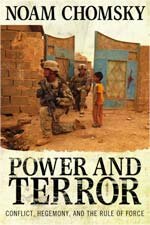By Daniel Levy, The Daily Beast – 16 April 2012
www.thedailybeast.com/articles/2012/04/16/of-herrings-and-elephants-benny-morris-and-palestinian-rejectionism.html
In his recent column for Open Zion, Benny Morris predicts that nothing will come of next week’s planned meeting between Israeli Prime Minister Netanyahu and the Palestinian who goes by the same title, Salam Fayyad. It is a safe prediction and one with which I fully agree. Morris however, uses his column to suggest that it is a prediction that can hold for any negotiation with any Palestinian, at any time, due to what he describes as a “deep, basic Palestinian rejectionism.” At the same time, settlements are belittled (they can be “finessed” according to Morris).

Nakba: Port of Haifa
Morris seems to be attempting to give a veneer of intellectual respectability to the well-rehearsed propagandist whining of apologists for Israeli policies and Israeli settlements. Israel’s Ambassador in Washington, Michael Oren, treads a similar path in his recent and thoroughly flawed plea for the resilience of Israeli democracy. The line goes: “As impediments to peace, settlements pale beside those posed by Palestinian … rejection of Israel’s right to exist.”
This is basic crutch on which much Israeli advocacy, or hasbara, rests, and which promotes status-quo thinking and policy on Israel/Palestine. So, let’s have at it.
To begin: A refresher on settlements. The built-up area of settlements in the West Bank, may take up only 1.2% of the territory, but the area under the municipal and regional planning and zoning jurisdiction covers over 42%. There are 124 of settlements and 100 so-called outposts in the West Bank. The 60% of the West Bank known as Area C, out of bounds for Palestinians, is in many ways defined by those settlements, as is the pattern of restrictions on Palestinian freedom of movement and the IDF’s deployment in the territories. The 13 settlements constructed beyond the international armistice line in East Jerusalem are home to some 187,000 Israeli Jews, roughly a quarter of the entire population of municipal Jerusalem.
Settler violence against Palestinians is well documented, including physical attacks, “price tag” arson attempts against Mosques, and the destruction of Palestinian farmland and olive groves. Settlements dominate water and other resource usage in the West Bank. One in ten Israeli Jews lives in a settlement, while one in five residents of the West Bank are settlers. Benny Morris describes the settlements as a “giant red herring.” Giant—yes. Red Herring—not so much.
Morris then treats us to the supposed history of Palestinian rejectionism, in which he displays a sloppiness with historical accuracy unbecoming of a man whose name is associated with that discipline. Morris describes the 1978 Camp David Agreement as promising Palestinian autonomy which, “would have devolved into statehood.” Morris knows very well that the Camp David Accords make no mention of statehood. He accuses Arafat in 2000 of rejecting a deal offering the Palestinians “100% of East Jerusalem” a flat-out and easily debunked lie (all proposals had Israel retaining control of much of East Jerusalem, including all 13 Israeli settlements there) and his depiction of the 2008 Olmert-Abbas talks is more cautious, but equally misleading.
However, Morris is most brazen when he is not actually cheating with the facts. In this column he criticizes the Palestinian leadership of the time for rejecting UNGA Resolution 181 in 1947, stipulating a partition of the British mandatory territory of Palestine into a Jewish state on 54%, an Arab State on 44% and a corpus separatum around Jerusalem.
But it is Benny Morris who has been most crystal clear in suggesting that this Resolution,181 (again, which he criticizes the Palestinians for rejecting), was actually a prescription for the “ethnic cleansing” (his term) of Palestinians from the area designated for Jewish statehood. Benny Morris in an interview with Haaretz in 2004, argued that given the implementation of Jewish statehood, of 181 (according to Morris) necessitated transfer, the forcible removing of Palestinians. In that interview he said the following:
Of course. Ben-Gurion was a transferist. He understood that there could be no Jewish state with a large and hostile Arab minority in its midst… There are circumstances in history that justify ethnic cleansing… A Jewish state would not have come into being without the uprooting of 700,000 Palestinians…There was no choice but to expel that population. It was necessary to cleanse the hinterland and cleanse the border areas and cleanse the main roads. It was necessary to cleanse the villages.
Morris heaps deceit upon deceit. He neutrally claims that “both sides’ starting position and their red lines are simply too far apart.” He is apparently indifferent to the fact that they have become so far apart, compared to the previous Olmert-Abbas talks that he describes, because the Netanyahu government shifted the goal posts, and has, in practice, rejected the premises on which the Olmert negotiating platform and the Clinton parameters were built.
Netanyahu refused to accept that a Palestinian state would be based on the ’67 line, and even berated President Obama for suggesting as much. The very idea that the Palestinians should be oh-so grateful for being offered statehood on less than the 22% that constitutes the ’67 lines-based dispensation, and accept a mini-state shorn of other attributes of sovereignty is a subject for another post.
Finally, let’s get to the nub, that the “historical deal-breaker” is “Palestinian rejectionism.” Morris is right to eschew an exclusive focus on technicalities (where to draw a new border, how many settlers to include/exclude, specific security arrangements, etc.). But to do justice to a deeper level of inquiry, one has to switch Mr. Morris’ animal metaphors; stop misattributing red herrings and start acknowledging the rather large elephant in the room. That elephant is, in historical terms, the Nakba—the Palestinian dispossession that came with the founding of the Jewish state; and in contemporary terms, the second-class status of Palestinian citizens within the Jewish state.
It is an elephant that Benny Morris is well equipped to recognize. Benny Morris the historian brought to light, in painful detail, the planned and forced expulsion of Palestinian towns and villages; of massacres and executions of Palestinians; and of incidents of rape against Palestinians.
After all, Benny Morris was a chronicler of the cleansing of the Palestinians before he became a champion of the cleansing of the Palestinians. In that 2004 interview, Morris concludes that Ben Gurion did not go far enough and that “[Ben Gurion] faltered… If he had carried out a full expulsion—rather than a partial one—he would have stabilized the State of Israel for generations.” Morris’ claim of Palestinian rejectionism rests on the idea that the Palestinians wrongly refuse to accept the legitimacy of the expulsion which he has detailed and of the regime of privilege that has denied Palestinian-Arab citizens full rights in the Jewish state. It is an unrealistic and illegitimate request to make of the Palestinians.
As important, it ignores the very real and unreciprocated distance that the Palestinians have traveled in accepting Israel. Contrary to the yarn of rejectionism that Morris spins, Yasser Arafat included the following in a September 1993 letter to then Israeli Prime Minister Yitzak Rabin: “The PLO recognizes the right of the state of Israel to exist in peace and security.” This was part of an exchange of letters of mutual recognition. Yet Rabin did not recognize the Palestinian right to a state; his recognition extended only to the PLO as being the “sole legitimate representatives of the Palestinian people.”
Probably the defining break was in November 1988 at the Palestine National Council meeting in Algiers in which the Palestinian Declaration of Independence was made. That declaration claimed that the legal basis for Palestinian statehood was indeed UNGA 181. And in the same declaration the PLO explicitly referenced the partition into “two states—Arab and Jewish.” This paved the way for the option of a two-state solution on the ’67 lines.
Rather than rejecting Israel, the PLO has adhered to the two-state, ‘67 principle ever since. And the Hamas leadership has increasingly moved in this direction, sometimes in more explicit tones. Similarly, when serious negotiations have taken place, Palestinian leaders have not stood on the right to implement a return of refugees to sovereign Israel. They have not swept their history under the carpet, nor denied that refugees have any rights. Yet they have understood that a two-state outcome would entail a compromise on this issue. In depicting Palestinian political and diplomatic history as one uninterrupted continuum of rejectionism, Morris either ignores or dismisses the distinct and evolving phases through which the Palestinian national movement has passed.
So why does Benny Morris continue to make the claims that he does? Morris has said that “the Arab world as it is today is barbarian.” He has suggested that “a cage has to be built” for the Palestinians, calling them “wild animals.” He has described Arab society as having “no moral inhibitions,” and described Islam as not having the same value as the West for human life. Perhaps he has simply been too blinded by his own prejudices.
And to cap it all, Morris suggests no alternative, no future, no hope. His only wink to a possible outcome is that the conditions may eventually come about that will allow, in his terms, the completion of Ben Gurion’s work—the full expulsion. For Morris, the cleansing of Arabs from Israel or Greater Israel is preferable to a shared, democratic alternative.
Yet, if two-state option is ultimately to have its day, then one can envisage three variations or ways in which this might come about. Let’s call the first the two-state diktat. That would be not too dissimilar to what we have now. The main difference being that the islands of limited Palestinian self-governance would be called a state and the conditions would be dictated by Israel; it is Bantustanization.
The second option is the two-state outcome. There is genuine de-occupation. The new border delineation is accepted, including in Jerusalem. Let’s call this addressing the ’67 issues, but not the deeper ’48 issues. And were it not for Israel’s own political cowardice and short sightedness, it could achieve a two-state outcome even without an “ideal” Palestinian partner.
Only the third possibility can be called a two state solution. And that would have to deal with history, with root causes. In this respect, Morris is right to take us back to the deeper levels of the conflict. If there is one day to be a solution, including a hard yet real process of truth and reconciliation, then the material of Benny Morris the historian may ironically have a prominent role to play. But first, we will have to overcome Benny Morris the bigot and the many who follow in his path.
Daniel Levy directs the Middle East Task Force at the New America Foundation and is a senior policy fellow at the European Council on Foreign Relations. He also co-edits the Middle East Channel.






































